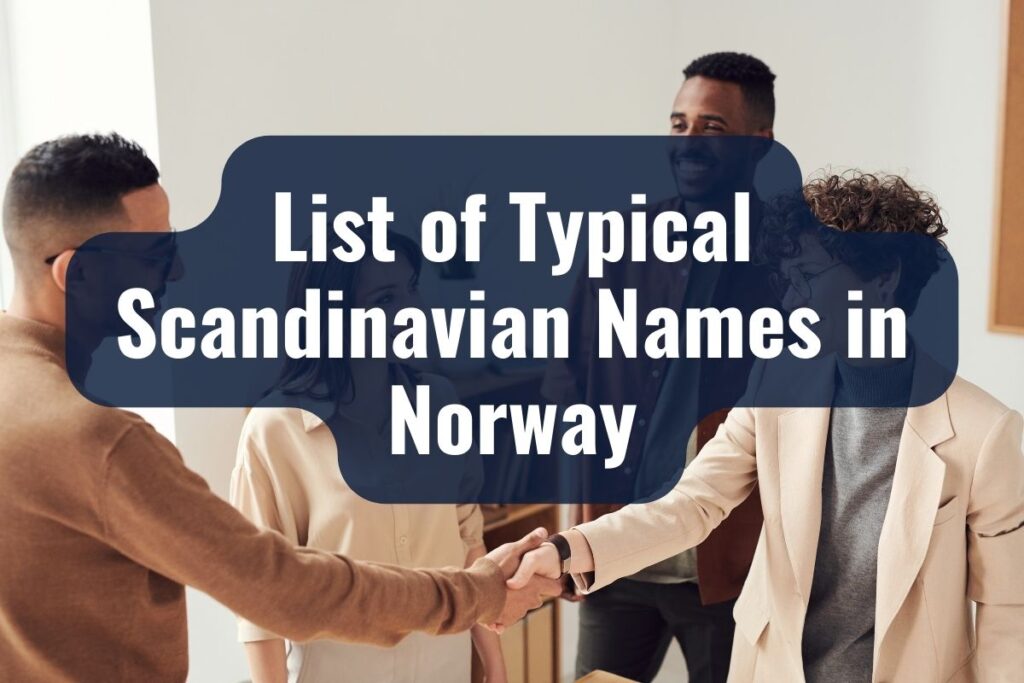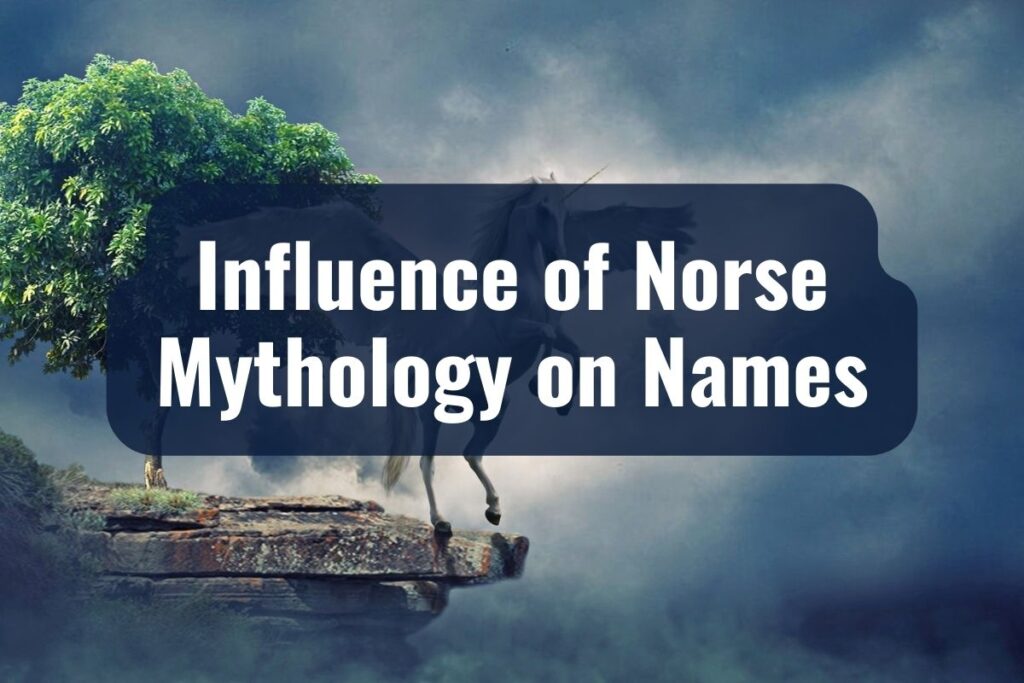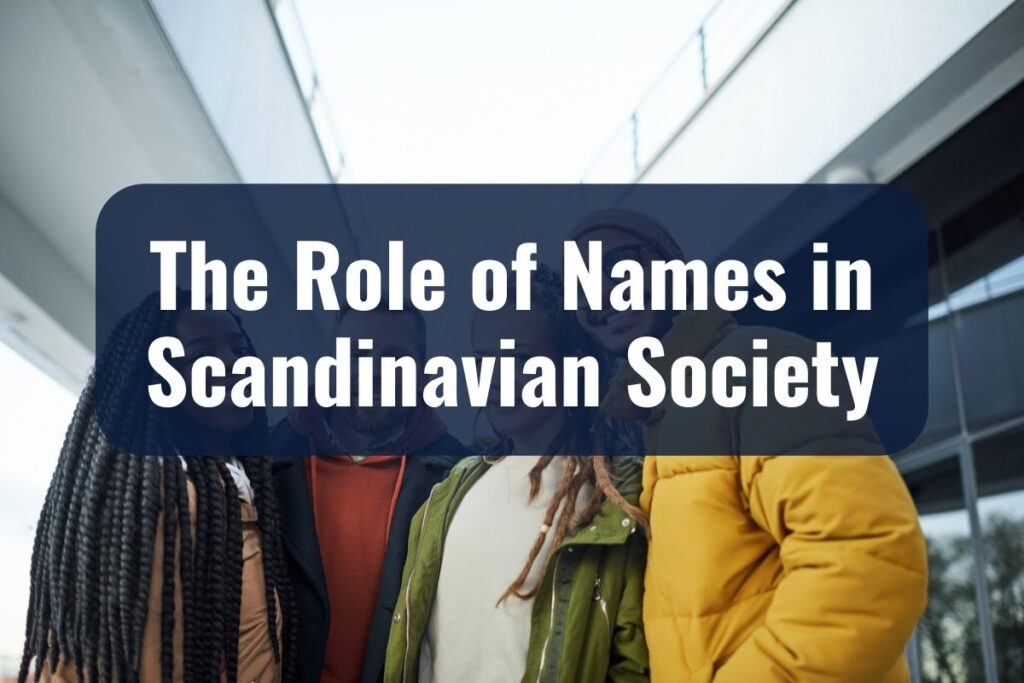Scandinavian names, with their unique sound and rich heritage, are a window into the diverse cultural tapestry of Norway and its neighboring countries. These names carry with them stories of the past, an embodiment of traditions, and a touch of the mystical landscapes that define the region. As you delve into the list of typical Scandinavian names, you embark on a journey through history, mythology, and the charming peculiarities of Nordic culture.
Understanding Scandinavian names is more than just learning a list of popular monikers; it’s about grasping the essence of a region that Vikings, sagas, and a profound connection to nature have shaped. Whether you are living in Norway, planning to name your child with a touch of Norse heritage, or simply fascinated by the cultural richness of this part of the world, this exploration will unveil the beauty and depth of Scandinavian names.
Key Takeaways
- Scandinavian names reflect a deep cultural connection to nature, mythology, and ancestral heritage.
- Traditional naming practices in Norway honor family and historical roots, with a strong emphasis on lineage.
- Norse mythology significantly influences Scandinavian names, imbuing them with mythic and legendary qualities.
- Contemporary Scandinavian naming trends blend traditional roots with global influences and modern values.
- Naming conventions vary across Scandinavian countries, each reflecting its unique cultural and linguistic identity.
- Understanding the pronunciation and spelling of Scandinavian names requires familiarity with specific linguistic nuances.
- Names in Scandinavian society hold social and cultural significance, reflecting identity, heritage, and values.
The roots of Scandinavian names stretch deep into the history and culture of the Nordic region. These names are not just mere labels but are imbued with meanings, stories, and a connection to the land and its history. Understanding their origins and significance offers a glimpse into the soul of Scandinavian culture, where every name tells a story.
Historical Background
The history of Scandinavian names can be traced back to the Viking Age and earlier. During this period, names were often chosen for their meanings and the qualities they represented. These names were deeply entwined with the Norse language and reflected the values and beliefs of the society. For example, names incorporating elements like ‘Thor’ (the Norse god of thunder) or ‘bjorn’ (bear) were common, symbolizing strength and bravery.
Cultural Significance
In Scandinavian culture, names are more than just identifiers; they are a part of one’s identity and heritage. Traditionally, names were passed down through generations, creating a sense of continuity and connection to ancestors. This practice highlights the deep respect for family and the past, which is a cornerstone of Scandinavian values.
Meanings and Themes
The meanings behind Scandinavian names often draw from nature, mythology, and the virtues admired by the society. Names that reflect natural elements like ‘Bjørk’ (birch tree) or ‘Stein’ (stone) showcase Scandinavians’ deep bond with their natural surroundings. Meanwhile, names derived from Norse mythology, such as ‘Freya’ (a goddess of love and fertility) or ‘Odin’ (the chief god), reflect the enduring influence of these ancient tales on modern Scandinavian culture.

Norwegian names often reflect the country’s profound connection with its history, nature, and mythology. Each name carries a unique story and significance, offering a glimpse into the values and traditions of Norwegian culture. Here, we will explore some of the most popular Norwegian names, unveiling the meanings and histories behind them.
| Name | Gender | Meaning | Origin |
| Ole | Male | Ancestor’s descendant | Old Norse |
| Lars | Male | Crowned with laurel | Latin |
| Henrik | Male | Home ruler | Old Norse |
| Anders | Male | Manly, brave | Old Norse |
| Magnus | Male | Great, mighty | Latin |
| Ingrid | Female | Beautiful, beloved | Old Norse |
| Astrid | Female | Divinely beautiful | Old Norse |
| Solveig | Female | Strong house, daughter of the sun | Old Norse |
| Anne | Female | Grace, favor | Hebrew |
| Helene | Female | Shining light | Greek |
Common Male Names in Norway
- Ole: A classic Norwegian name, Ole is derived from the Old Norse word ‘Anulo,’ meaning ‘ancestor’s descendant’. It’s a name that resonates with the importance of heritage in Norwegian culture.
- Lars: Meaning ‘crowned with laurel,’ Lars has roots in Latin and is widely used across Scandinavia. It symbolizes victory and honor.
- Henrik: The Norwegian form of Henry, Henrik means ‘home ruler’ or ‘lord of the house,’ signifying leadership and strength.
- Anders: A variant of Andrew, Anders means ‘manly’ or ‘brave,’ reflecting the value placed on courage and strength in Norse culture.
- Magnus: Originating from Latin, Magnus means ‘great’ or ‘mighty.’ This name was borne by kings and nobles, highlighting its regal and powerful connotations.
Common Female Names in Norway
- Ingrid: Deriving from Old Norse elements meaning ‘beautiful’ and ‘beloved,’ Ingrid is a name that conveys beauty and grace.
- Astrid: Meaning ‘divinely beautiful,’ Astrid combines elements of the divine and the natural, a reflection of the deep-rooted Norse reverence for beauty and nature.
- Solveig: This name, meaning ‘strong house’ or ‘daughter of the sun,’ is unique to Scandinavia. It reflects the themes of strength and light, central to Norse culture.
- Anne: A form of Anna, Anne means ‘grace’ or ‘favor.’ It’s a simple yet elegant name that has been popular for generations.
- Helene: Derived from the Greek ‘Helénē,’ Helene means ‘shining light.’ It’s a name that conveys brightness and inspiration.
Naming Traditions in Norway
Norwegian naming traditions are a fascinating blend of historical customs, family heritage, and cultural values. These traditions not only guide how names are chosen but also reflect the deep-rooted connection Norwegians have with their past and the natural world around them. Understanding these practices offers a window into the soul of Norwegian society and its reverence for ancestry and tradition.
The Importance of Family Names
Legacy and Ancestry: In Norway, it’s common to name children after grandparents or other relatives. This practice honors ancestors and keeps their memory alive in new generations. It reflects the Norwegian value of familial bonds and respect for lineage.
Patronymic and Matronymic Systems: Historically, Norwegians used a patronymic system, where a child’s surname was derived from the father’s first name with the addition of ‘sen’ (son) or ‘datter’ (daughter). Although this system is no longer the standard, it showcases the importance of paternal lineage in Norwegian culture.
Nature-Inspired Names
Connection with Nature: Many Norwegian names are inspired by the country’s breathtaking landscapes and natural phenomena. Names like ‘Bjørn’ (bear) or ‘Hav’ (sea) exemplify the deep connection Norwegians have with their natural surroundings.
Symbolism: These nature-inspired names often carry symbolic meanings. For instance, a name like ‘Einar,’ meaning ‘one who fights alone,’ is reminiscent of the rugged, individualistic spirit often attributed to the Norse.
Contemporary Influences
Modern Shifts: While traditional naming practices are still respected, there’s been a shift towards more diverse and international names in recent years. This change reflects Norway’s increasingly global perspective and the influence of international media and culture.
Regulations: Norway has specific laws governing naming. Names can’t cause inconvenience to the individual and must align with Norwegian orthography and tradition. This legal framework ensures that names remain meaningful and culturally relevant.
Influence of Norse Mythology on Names

Norse mythology, a central pillar of Scandinavian heritage, has significantly influenced the naming traditions in Norway. These mythological tales, filled with gods, goddesses, and legendary heroes, have left an indelible mark on the way Norwegians name their children. This section explores how the ancient sagas and mythic figures of Norse lore continue to inspire Norwegian names, weaving a thread of mythological magic into modern identities.
Names Inspired by Norse Gods and Goddesses
- Odin: Derived from the chief god in Norse mythology, the name Odin symbolizes wisdom, poetry, and war. It represents a strong, charismatic, and insightful character.
- Freya: Named after the goddess of love, beauty, and fertility, Freya is a popular name that embodies charm and allure. It reflects the cultural importance of love and nature in Norse beliefs.
- Thor: This name comes from the Norse god of thunder and strength. Thor represents power, protection, and bravery, qualities highly esteemed in Norse culture.
- Loki: While a more controversial figure, the name Loki, associated with the trickster god, signifies intelligence and cunning. It’s less common but notable for its mythological background.
Legendary Heroes and Figures
- Sigurd: Stemming from the legendary hero Sigurd, who slayed the dragon Fafnir, this name epitomizes courage and victory. It’s a nod to the valorous tales that are a staple of Norse mythology.
- Brynhild: Inspired by the shieldmaiden Brynhild in the Völsunga saga, this name signifies strength and determination. It reflects the empowered role of women in some Norse tales.
Mythological Themes and Virtues
- Astrid: Meaning ‘divinely beautiful,’ Astrid combines elements of the divine and natural beauty, resonating with the aesthetic themes prevalent in Norse mythology.
- Runa: Deriving from the Old Norse word for ‘secret’ or ‘mystery,’ Runa encapsulates the mystical and enigmatic aspects of Norse lore.
The landscape of Scandinavian naming practices, while deeply rooted in tradition and history, is not immune to the winds of change. Modern trends in naming reflect a blend of these enduring traditions with a growing influence of global culture, showcasing a dynamic and evolving aspect of Norwegian and broader Scandinavian identity. This section delves into the contemporary trends in Scandinavian naming, highlighting how these names are adapting to a changing world while retaining their unique cultural essence.
Embracing Global Influences
International Names
With increased global connectivity, there has been a rise in the popularity of names from other cultures within Scandinavia. Names like Emma, Lucas, and Liam, while not traditionally Scandinavian, have found a place in the region, symbolizing a more cosmopolitan approach to naming.
Crossover Names
There’s a growing trend of choosing names that are easily pronounceable and recognizable in various languages. This shift facilitates international mobility and reflects the increasingly interconnected nature of the modern world.
Revival of Old Norse Names
Return to Roots
Alongside global influences, there’s a resurgence in the popularity of old Norse and traditional Scandinavian names. Names like Ivar, Leif, and Astrid are experiencing a revival, as modern parents seek to reconnect with their heritage.
Rediscovery of Rare Names
There’s also a trend toward rediscovering lesser-known traditional names, bringing them back into contemporary use. This movement signifies a deeper exploration and appreciation of Scandinavian history and culture.
Names Reflecting Modern Values
Nature-Inspired Names
Reflecting a growing global emphasis on environmental consciousness, Scandinavian names inspired by nature have become increasingly popular. Names like Linnea (a flower), Bjørn (bear), and Fjell (mountain) showcase a continued reverence for the natural world.
Gender-Neutral Names
In line with the progressive views on gender in Scandinavia, there’s an increasing preference for gender-neutral names. This trend reflects the region’s commitment to equality and inclusivity.

While Norway shares a deep cultural and historical bond with its Scandinavian neighbors – Sweden, Denmark, and Iceland – each country has its own unique naming conventions and trends. This section offers a comparative perspective on how Norwegian names relate to, differ from, and influence the naming practices in these neighboring countries, illuminating the rich diversity within the Scandinavian naming tapestry.
Roots in Norse Mythology: All Scandinavian countries draw inspiration from Norse mythology, with names like Freya, Erik, and Thor being popular across the region. This shared heritage reflects the common ancestral and cultural background.
Nature-Inspired Names: The deep connection with nature is a characteristic shared across Scandinavian countries. Names like Björn (Sweden), Søren (Denmark), and Einar (Iceland) are examples of how natural elements and landscapes influence naming choices.
Historical Significance: Each country has a strong tradition of choosing names with historical and cultural significance, ensuring that ancient Norse traditions and legends are preserved and celebrated.
Distinctive Trends in Each Country
Sweden: Swedish names often have a melodic and gentle quality, with names like Linnea, Gustav, and Alva. There’s also a preference for names that have a timeless and classic feel.
Denmark: Danish names tend to be short and robust, with a trend towards older, traditional names making a comeback. Examples include Mads, Freja, and Lærke.
Iceland: Unique among the Scandinavian countries, Iceland still largely adheres to the patronymic or matronymic naming system. Names are deeply tied to Icelandic language and heritage, with examples like Björk and Snorri.
The Influence of Language and Local Customs
Pronunciation and Spelling: While many names are shared across Scandinavian countries, variations in pronunciation and spelling can be attributed to linguistic differences. For example, the name ‘Karl’ is found in all Scandinavian countries but with slight variations in pronunciation and spelling.
Local Naming Laws and Customs: Each country has specific laws and traditions governing naming. For instance, the Danish and Icelandic naming committees regulate the names that can be given to children, ensuring they are in line with linguistic and cultural norms.
Navigating the pronunciation and spelling of Scandinavian names can be a delightful yet challenging task, especially for those unfamiliar with the linguistic nuances of the region. Norwegian and other Scandinavian languages have distinctive sounds and orthographic rules that shape the way names are pronounced and spelled. This section aims to demystify these aspects, providing insights to help appreciate and accurately pronounce these unique names.
Key Aspects of Pronunciation
Vowel Sounds: Scandinavian languages have a rich array of vowel sounds, some of which do not have direct equivalents in English. For example, the Norwegian name ‘Åse’ requires the pronunciation of the ‘å’ sound, which is akin to the ‘o’ in ‘more’.
Consonant Variations: Certain consonants are pronounced differently than in English. For instance, the ‘j’ in Scandinavian names like ‘Jens’ is pronounced as ‘y’, similar to ‘yes’ in English.
Stress Patterns: The emphasis on syllables in Scandinavian names can be different from English. Generally, the stress is on the first syllable, as in ‘Magnus’ (MAH-gnus).
Tonal Qualities: Norwegian and Swedish have tonal qualities, where the pitch or intonation can change the meaning. This aspect is particularly important in correctly pronouncing names.
Understanding Spelling Conventions
Unique Alphabets: Scandinavian alphabets include letters not found in the English alphabet, such as ‘ø’, ‘æ’, and ‘å’ in Norwegian. These letters are crucial for correct spelling and pronunciation.
Combination of Letters: Certain letter combinations create unique sounds. For example, ‘kj’ and ‘sj’ in Norwegian produce sounds that don’t have direct English equivalents.
Use of Diacritics: Diacritics, such as accents and dots, can significantly alter the pronunciation of a name. For instance, ‘ä’ and ‘ö’ in Swedish have distinct sounds from their unmarked counterparts.
Tips for Non-Native Speakers
- Listening to Native Pronunciation: One of the best ways to learn is by listening to native speakers. Utilizing online resources or language apps can be highly beneficial.
- Practice and Patience: Practicing the pronunciation of these names, preferably with feedback from native speakers, is key. It’s important to be patient and open to learning.
- Understanding Regional Variations: Be aware that there can be regional variations in pronunciation within each Scandinavian country.

Names in Scandinavian society are more than mere identifiers; they are a reflection of cultural identity, social norms, and a deep-seated respect for heritage. In Norway and its neighboring Scandinavian countries, names carry significant weight, embodying the values, history, and aspirations of the people. This section explores the multifaceted role of names in Scandinavian society, highlighting their importance beyond the simple act of naming.
Cultural Identity and Heritage
Connection to the Past: Names in Scandinavia often serve as a bridge between the present and the past. They are a means of preserving and honoring cultural heritage, linking individuals to their ancestral roots and the broader historical narrative of the region.
Expression of Cultural Values: Names can reflect the values and beliefs held dear in Scandinavian societies, such as a love for nature, respect for ancient traditions, and a strong sense of community. Names inspired by nature or Norse mythology, for instance, speak to these deeply ingrained cultural priorities.
Social Significance
Markers of Identity: In Scandinavian cultures, names are seen as integral to one’s personal identity. They are often chosen to convey certain qualities or characteristics that parents hope to imbue in their child, reflecting the aspirations and identities of the family.
Inclusivity and Equality: With a growing trend towards gender-neutral names, Scandinavian societies are reflecting their progressive views on gender equality and inclusivity through naming practices. This shift signifies a broader societal commitment to these values.
Personal Connections and Relationships
Naming Customs and Family Ties: The custom of naming children after family members, particularly in Norway, strengthens family bonds and reinforces relationships across generations. It is a practice that speaks to the importance of family and continuity in Scandinavian life.
Unique Names and Individuality: While tradition plays a significant role, there is also a value placed on individuality and uniqueness in naming. This balance between tradition and individual expression is a hallmark of Scandinavian societal values.
Names as a Social Commentary
Reflecting Social Changes: The evolution in naming trends often mirrors changes in society, such as increased globalization or shifts in societal norms. As such, names can provide insightful commentary on the social and cultural dynamics of the time.
Legal and Ethical Considerations: The legal frameworks around naming in Scandinavian countries also reflect societal norms and values. They ensure that names are not only culturally and linguistically appropriate but also considerate of the individual’s welfare.
Additional Resources
- Nordic Names: Comprehensive books that delve into the etymology, history, and cultural significance of Scandinavian names. These often include dictionaries of names or thematic explorations of naming traditions in the Nordic countries.
- Norse Mythology: Books on Norse mythology can provide context and background for many traditional Scandinavian names. Works by authors like Neil Gaiman or the classic Eddas offer a deep dive into the mythological roots of many names.
- Nordic Names Website: An extensive online database that provides detailed information about Scandinavian names, including their meanings, origins, and popularity trends.
- Language Learning Platforms: Websites and apps dedicated to Scandinavian languages can be helpful for understanding pronunciation and linguistic nuances of names.
- Cultural Blogs and Websites: Numerous Nordic cultural websites and blogs discuss the traditions, history, and modern practices of naming in Scandinavian countries.
- National Statistics Bureaus: The official websites of Scandinavian countries’ statistics bureaus often publish lists of popular names, offering a glimpse into contemporary naming trends.
- Cultural Heritage Institutions: Websites of museums or cultural institutions in Scandinavian countries sometimes have resources or exhibits related to names and their historical contexts.


